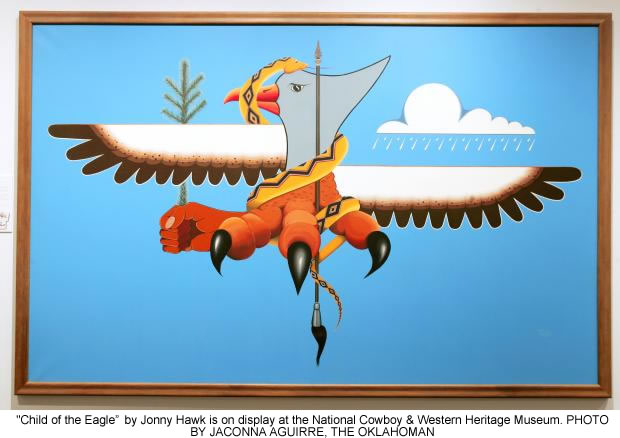 |
Canku Ota
|
 |
|
(Many Paths)
|
||
|
An Online Newsletter
Celebrating Native America
|
||
|
February 1, 2009 - Volume
7 Number 2
|
||
|
|
||
|
Exhibit displays
American Indian works created in Oklahoma in 1930s, '40s Murals
|
||
|
by BRANDY McDONNELL
- The Oklahoman
|
||
|
Credits:
Photos by Jaconna Aguirre - The Oklahoman
|
|
An exhibit of American Indian murals is not only offering visitors a chance to see the works of famed Oklahoma artists, it is encouraging them to take a road trip to view even more paintings.
The National Cowboy & Western Heritage Museum is tracing the mural painting tradition from prehistoric times to present day in the exhibition "American Indian Mural Painting in Oklahoma and the Southwest.” On display through May 3, it is drawn primarily from the museum’s expansive Silberman Collection of American Indian art. "That was really kind of the inspiration for this exhibit, because we are fortunate to have a number of these large-scale works,” said Steve Grafe, the museum’s American Indian art curator. The show includes six large-scale paintings from the museum’s collection, including murals by renowned Oklahoma Indian artists Woody Crumbo (Potawatomi), Acee Blue Eagle (Creek/Pawnee) and Archie Blackowl (Cheyenne). Along with smaller sketches, it also features murals by Romando Vigil (San Ildefonso Pueblo), Tonita Pena (San Ildefonso Pueblo) and Jonny Hawk (Creek/Seminole). In addition, Hopi artist Michael Kabotie has loaned the museum two of his "silver rooms” for the show. With his small silver overlays, he re-creates the intricate mural designs on the walls of the kivas, or ceremonial chambers, inside the ancestral Hopi villages of Awat’ovi and Pottery Mound. But the exhibit focuses primarily on works created in Oklahoma in the 1930s and ’40s, when many cash-strapped artists found work painting murals in public buildings as part of the New Deal. "When the Indian fine arts movement started, the non-Indian people who were teaching decided that Indian art was supposed to be flat, have no horizon line, no perspective ... because they were using ledger art and pottery decoration as their templates,” Grafe said. "The style of work they did was really well-suited to large murals for public buildings.” Some of the paintings in the exhibit once hung in public buildings. Blue Eagle’s triptych "Thunderbird & Buffalo Symbols” was painted in 1937 for the Muskogee Public Library and later salvaged when the building fell into disrepair. Blackowl’s "The Arrow Maker” and an untitled Crumbo canvas were created for the boys dormitory at the Fort Sill Indian School. "I was astonished as I started doing research. ... I didn’t have any idea that the mural painting tradition, the Depression-era work, had been as important and as expansive as it was,” he said. People still can see American Indian murals in many Oklahoma institutions, including the community post offices in Seminole, Okemah, Marietta, Coalgate, Nowata and Anadarko. Visitors to the museum’s mural exhibit can pick up cards detailing the locations of the post offices and the artworks displayed in each one. People are encouraged to travel to each post office and get a postmark on the card in the space provided. In March, Mark White, associate professor of art history at Oklahoma State University, will lead a museum bus tour to view New Deal-era murals in central Oklahoma. "Six post offices in this state have murals by Indian artists, and there are another 25 who have murals by non-Indian artists ... so it’s a pretty rich tradition,” Grafe said. |
|
|
||
|
|
||
| Canku Ota is a free Newsletter celebrating Native America, its traditions and accomplishments . We do not provide subscriber or visitor names to anyone. Some articles presented in Canku Ota may contain copyright material. We have received appropriate permissions for republishing any articles. Material appearing here is distributed without profit or monetary gain to those who have expressed an interest. This is in accordance with Title 17 U.S.C. Section 107. | ||
|
Canku Ota is a copyright ©
2000, 2001, 2002, 2003, 2004, 2005, 2006, 2007, 2008, 2009 of Vicki
Barry and Paul Barry.
|
||
 |
 |
|
|
The "Canku
Ota - A Newsletter Celebrating Native America" web site and
its design is the
|
||
|
Copyright ©
1999, 2000, 2001, 2002, 2003, 2004, 2005,
2006, 2007, 2008 of Paul C.
Barry.
|
||
|
All Rights Reserved.
|
||
